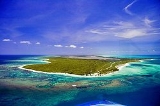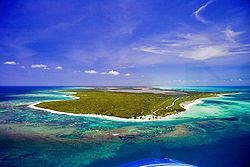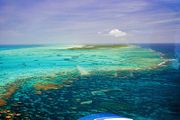
Anegada
Encyclopedia

British Virgin Islands
The Virgin Islands, often called the British Virgin Islands , is a British overseas territory and overseas territory of the European Union, located in the Caribbean to the east of Puerto Rico. The islands make up part of the Virgin Islands archipelago, the remaining islands constituting the U.S...
, a group of islands which form part of the archipelago
Archipelago
An archipelago , sometimes called an island group, is a chain or cluster of islands. The word archipelago is derived from the Greek ἄρχι- – arkhi- and πέλαγος – pélagos through the Italian arcipelago...
of the Virgin Islands
Virgin Islands
The Virgin Islands are the western island group of the Leeward Islands, which are the northern part of the Lesser Antilles, which form the border between the Caribbean Sea and the Atlantic Ocean...
. It lies approximately 15 miles (24.1 km) north of Virgin Gorda
Virgin Gorda
Virgin Gorda is the third-largest and second most populous of the British Virgin Islands . Located at approximately 18 degrees, 48 minutes North, and 64 degrees, 30 minutes West, it covers an area of about...
. Anegada is the only inhabited British Virgin Island formed from coral
Coral
Corals are marine animals in class Anthozoa of phylum Cnidaria typically living in compact colonies of many identical individual "polyps". The group includes the important reef builders that inhabit tropical oceans and secrete calcium carbonate to form a hard skeleton.A coral "head" is a colony of...
and limestone
Limestone
Limestone is a sedimentary rock composed largely of the minerals calcite and aragonite, which are different crystal forms of calcium carbonate . Many limestones are composed from skeletal fragments of marine organisms such as coral or foraminifera....
, rather than being of volcanic
Volcano
2. Bedrock3. Conduit 4. Base5. Sill6. Dike7. Layers of ash emitted by the volcano8. Flank| 9. Layers of lava emitted by the volcano10. Throat11. Parasitic cone12. Lava flow13. Vent14. Crater15...
origin. While the other islands are mountainous, Anegada is flat and low. Its highest point is only about 28 feet (8.5 m) above sea level, earning it the name which translates as “the drowned land.”
At about 15 square miles (38 square kilometers), Anegada is the second largest of the British Virgin Islands, but it is also the most sparsely populated of the main islands (population roughly 200). Most of the population on Anegada live in the main town, The Settlement
The Settlement (BVI)
The Settlement is the main and only town on Anegada in the British Virgin Islands in the Caribbean.-The Town:The Settlement lies near Lower Bay at the southwestern part of the island and has about 200 inhabitants...
.
Tourism
The primary business on Anegada is tourism. On a typical day during the tourist season, the island will have an additional 200 or so visitors. Commercial fishing is also a substantial business on Anegada, with local fishermen providing the majority of the fresh fish and lobster catch for the rest of the British Virgin Islands.Its miles of south shore flats has a large population of bonefish
Bonefish
The bonefish is the type species of the Albulidae family, or bonefishes in order Albuliformes. It is amphidromous, living in inshore tropical waters, moving onto shallow mudflats to feed with the incoming tide, and retreating to deeper water as the tide ebbs...
, making Anegada a popular destination for fly fishing
Fly fishing
Fly fishing is an angling method in which an artificial 'fly' is used to catch fish. The fly is cast using a fly rod, reel, and specialized weighted line. Casting a nearly weightless fly or 'lure' requires casting techniques significantly different from other forms of casting...
.
Access to the island is via the small Auguste George Airport
Auguste George Airport
Auguste George Airport is the northern most airport in the British Virgin Islands and is located on the island of Anegada. The airport is named for Captain Auguste George....
(NGD), thrice-weekly ferries
Ferry
A ferry is a form of transportation, usually a boat, but sometimes a ship, used to carry primarily passengers, and sometimes vehicles and cargo as well, across a body of water. Most ferries operate on regular, frequent, return services...
, and private boat. Island Birds Air Charter also flies directly to Anegada from San Juan, St Thomas, Antigua or St Maarten.
Horseshoe Reef

Coral reef
Coral reefs are underwater structures made from calcium carbonate secreted by corals. Coral reefs are colonies of tiny living animals found in marine waters that contain few nutrients. Most coral reefs are built from stony corals, which in turn consist of polyps that cluster in groups. The polyps...
in the Caribbean
Caribbean Sea
The Caribbean Sea is a sea of the Atlantic Ocean located in the tropics of the Western hemisphere. It is bounded by Mexico and Central America to the west and southwest, to the north by the Greater Antilles, and to the east by the Lesser Antilles....
, and the fourth largest on earth. The reef makes navigation to Anegada difficult. While charter boats freely sail among most of the other Virgin Islands, charter companies often forbid clients to sail to Anegada to avoid running aground on the reef.
The reef has claimed hundreds of shipwrecks, including HMS Astraea in 1808, the Donna Paula (1819), the MS Rocus (1929) As such, it was once an important scuba diving
Scuba diving
Scuba diving is a form of underwater diving in which a diver uses a scuba set to breathe underwater....
destination. In an effort to protect the reef, the BVI government has made anchoring on Horseshoe Reef illegal.
Fauna
Anegada is also known for miles of white sand beaches, the large salt ponds which cover much of the west end of the island, and unique fauna. In the 1830s thousands of Caribbean FlamingoCaribbean Flamingo
The American Flamingo is a large species of flamingo closely related to the Greater Flamingo and Chilean Flamingo. It was formerly considered conspecific with the Greater Flamingo, but that treatment is now widely viewed as incorrect due to a lack of evidence...
s lived in these ponds, but they were hunted for food and feathers throughout the 19th and early 20th centuries and disappeared by 1950. They are now being re-established into the ponds. The birds are another tourist draw, but officials are trying to keep the number of visitors to the flamingo areas at a level that allows the birds to flourish.
Other rare or endangered animals include the Anegada rock iguana (Cyclura pinguis
Cyclura pinguis
The Stout Iguana or Anegada Ground Iguana is a critically endangered species of lizard of the genus Cyclura belonging to the Iguanidae family. The species can be found exclusively in the island of Anegada...
) and several species of turtle
Turtle
Turtles are reptiles of the order Testudines , characterised by a special bony or cartilaginous shell developed from their ribs that acts as a shield...
s. Conch
Conch
A conch is a common name which is applied to a number of different species of medium-sized to large sea snails or their shells, generally those which are large and have a high spire and a siphonal canal....
, Caribbean lobster (Metanephrops binghami
Metanephrops binghami
Metanephrops binghami, the Caribbean lobster or Caribbean lobsterette, is a lobster which inhabits the western Atlantic region: from the Bahamas and southern Florida to French Guiana, including the Gulf of Mexico and the Caribbean Sea....
), and many fishes can be found near Anegada, particularly in the deep waters off the North Drop to the north of the island.
The reef adjacent to the Settlement used to be one of the more fertile conch grounds in the Caribbean, but overfishing has wiped out the conch population at the site. Visitors to the settlement are greeted by the sight of mountains of empty conch shells on the shore when they arrive.
There are also populations of feral
Feral
A feral organism is one that has changed from being domesticated to being wild or untamed. In the case of plants it is a movement from cultivated to uncultivated or controlled to volunteer. The introduction of feral animals or plants to their non-native regions, like any introduced species, may...
cattle
Cattle
Cattle are the most common type of large domesticated ungulates. They are a prominent modern member of the subfamily Bovinae, are the most widespread species of the genus Bos, and are most commonly classified collectively as Bos primigenius...
, donkey
Donkey
The donkey or ass, Equus africanus asinus, is a domesticated member of the Equidae or horse family. The wild ancestor of the donkey is the African Wild Ass, E...
s, goat
Goat
The domestic goat is a subspecies of goat domesticated from the wild goat of southwest Asia and Eastern Europe. The goat is a member of the Bovidae family and is closely related to the sheep as both are in the goat-antelope subfamily Caprinae. There are over three hundred distinct breeds of...
s and sheep which live in all areas of the island.
Western Salt Ponds of Anegada was designated a Ramsar Site
Ramsar Convention
The Ramsar Convention is an international treaty for the conservation and sustainable utilization of wetlands, i.e., to stem the progressive encroachment on and loss of wetlands now and in the future, recognizing the fundamental ecological functions of wetlands and their economic, cultural,...
on 11 May 1999.
Hurricanes
On the 30 August 2010 the eye of Hurricane EarlHurricane Earl (2010)
Hurricane Earl was a long-lived, powerful tropical cyclone which became the first major hurricane to threaten New England since Hurricane Bob in 1991. The fifth named storm of the 2010 season, Earl developed out of a tropical wave roughly west of the Cape Verde Islands on August 25...
passed quite close by just north of Anegada (30-40 km). The close passage led to significant damage from the hurricane on the island with major flooding from the storm surge
Storm surge
A storm surge is an offshore rise of water associated with a low pressure weather system, typically tropical cyclones and strong extratropical cyclones. Storm surges are caused primarily by high winds pushing on the ocean's surface. The wind causes the water to pile up higher than the ordinary sea...
.

